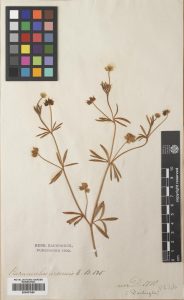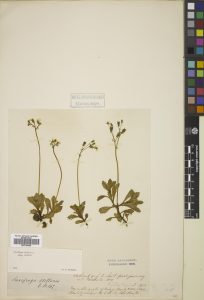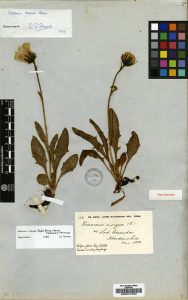The Backhouse family is more widely known for their nursery based in the north of England. However, several members of the family also collected herbarium specimens which are now held in herbaria in Edinburgh, London, Melbourne and Missouri. To date we have found and databased nearly 250 specimens in the RBGE Herbarium and these can be found on our online Herbarium Catalogue here.
Three specimens have been selected to be on show at the launch of the new The Backhouse Heritage & Education Centre at the Rossie Estate.
- Ranunculus arvensis L. (http://data.rbge.org.uk/herb/E00431055)
 This Ranunculus species was included by Linnaeus in his ground-breaking “Species Plantarum” in 1753, now considered as the starting point for the modern system of naming plants.
This Ranunculus species was included by Linnaeus in his ground-breaking “Species Plantarum” in 1753, now considered as the starting point for the modern system of naming plants.
This specimen of Ranunculus arvensis, from near Darlington, was collected in 1810 by William Backhouse. William’s herbarium was believed to have been destroyed by a fire at Thirsk in 1864, but fortunately some specimens were included in at least two other collections and these are now held at the Royal Botanic Garden Edinburgh and the Natural History Museum in London.
The E.B. on the specimen refers to James Sowerby’s ‘English Botany’ (a major publication of British plants, issued between 1790 and 1813).
The Backhouse Herbarium was purchased by the Royal Botanic Garden Edinburgh in 1908, but no further information about this purchase has yet been uncovered.
2. Saxifraga stellaris L. subspecies stellaris (http://data.rbge.org.uk/herb/E00740300)
 This specimen was collected by William’s cousin, James Backhouse senior (1794-1869). James had been inspired to start studying plants from the age of nine when he inherited his brother Nathan’s herbarium. This specimen was collected in 1810 when James would have been about 16 years old. The writing on the specimen says “Gathered on J.B. Senior’s first journey into Teesdale. 1810. Middleton Teesdale 1810. Bog in the angle of Maize Beck and the Tees. Locality shown to J.B. by John Binks.” John Binks (1766-1817) was a Durham lead miner who is credited with finding many rare plants in the area and who was a big influence in James’ life.
This specimen was collected by William’s cousin, James Backhouse senior (1794-1869). James had been inspired to start studying plants from the age of nine when he inherited his brother Nathan’s herbarium. This specimen was collected in 1810 when James would have been about 16 years old. The writing on the specimen says “Gathered on J.B. Senior’s first journey into Teesdale. 1810. Middleton Teesdale 1810. Bog in the angle of Maize Beck and the Tees. Locality shown to J.B. by John Binks.” John Binks (1766-1817) was a Durham lead miner who is credited with finding many rare plants in the area and who was a big influence in James’ life.
Later in his life James travelled to South Africa and Australia, where his botanising resulted in a new genus, Backhousia, being named after him by William Hooker and William Harvey in 1845.
3. Hieracium insigne Backh.f. (http://data.rbge.org.uk/herb/E00031652)
 This was a new species described by James Backhouse junior (1825-1890) in 1853. The name was published in the minutes of the Botanical Society of Edinburgh (in The Phytologist: a popular botanical miscellany). The meeting had been held on Thursday, December 9, 1852 and was chaired by Professor Balfour who was the President of the Society as well as the Professor of Botany at the University of Edinburgh and the Regius Keeper of the Royal Botanic Garden Edinburgh. As well as discussing the alarming effect of swallowing a quarter of a seed of poison nut by Professor Christison, the group looked over a range of donations to the Society.
This was a new species described by James Backhouse junior (1825-1890) in 1853. The name was published in the minutes of the Botanical Society of Edinburgh (in The Phytologist: a popular botanical miscellany). The meeting had been held on Thursday, December 9, 1852 and was chaired by Professor Balfour who was the President of the Society as well as the Professor of Botany at the University of Edinburgh and the Regius Keeper of the Royal Botanic Garden Edinburgh. As well as discussing the alarming effect of swallowing a quarter of a seed of poison nut by Professor Christison, the group looked over a range of donations to the Society.
These included over 40 Hieracium specimens collected by Backhouse. They had been collected from across Scotland and northern England. In the minutes is was noted “Mr Backhouse thinks that H. chrysanthum, H. globosum, H. alpestre, and H. argenteum will prove to be good species, but that there is some doubt regarding H. affine, H. gracilentum, and H. insigne.” However, Hieracium insigne is still recognised as a species today.
The original specimen that was presented at that meeting can be seen here, over 150 years later. It is the type specimen of Hieracium insigne. A type specimen, along with the original description, defines the name of a species and becomes the permanent reference for that name. It is usually the specimen that the author was looking at when describing the species, and is therefore critical for taxonomic research.
Postscript
In selecting these specimens for the launch of the Backhouse Heritage and Education Centre it has become clear that there is considerable confusion in assigning many of the specimens to the correct member of the Backhouse family. Additional research will be needed to disentangle the individual collecting histories, localities and dates.
References:
Welch, B. (1958). The Herbarium of James I’Anson of Darlington. Proc. BSBI. 3, 39-40; pdf
Proceedings of the Botanical Society of Edinburgh, (1853). The Phytologist: a popular botanical miscellany, Vol. 4, 803-812 (http://www.biodiversitylibrary.org/item/55356#page/853/mode/1up)
